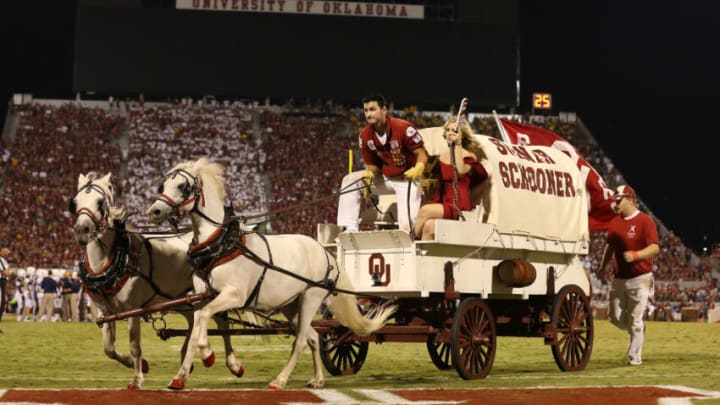Everyone who follows Oklahoma football, and even fans nationally, are familiar with the iconic Sooner Schooner.
It’s a one of a kind, as far as official mascots go, and is easily identifiable with Oklahoma football. But what is the Sooner Schooner story and what is its origin?
The conestoga wagon powered by two white ponies was introduced during the 1964 football season and since then has made thousands of trips across Owen Field in celebration of Oklahoma scoring drives. The iconic mascot is designed as a scaled-down replica of the Studebaker Conestoga wagon used by settlers of the Oklahoma territory during the time of the Oklahoma Land Run in the late 1800s.
The Sooner Schooner name is derived from the term “prairie schooners,” the common term used to describe the wagons of the settlers who snuck into the territory before it was officially opened for settlement. The settlers who jumped the gun during the Land Run and went early were known as “Sooners.”
The Schooner is led by two white ponies, appropriately named “Boomer” and “Sooner.” The ponies are kept at the Bartlett Ranch in Sapulpa, Oklahoma.
The Sooner Schooner is maintained and driven by members of the RUF NEKS and the RUF NEKs Lil’ Sis, the university’s all-male and all-female spirit squads, respectively.
Over the years, the Sooner Schooner has been involved in several memorable incidents.
1985 Orange Bowl
During the 1985 Orange Bowl between Oklahoma and Washington, with the score tied 14-14 in the fourth quarter, Oklahoma appeared to have successfully executed a 22-yard field goal that put OU ahead 17-14. The Sooner Schooner rode out on the field, as it traditionally does after OU scores during home and bowl games, but the field goal was nullified by an illegal procedure penalty called on Oklahoma when a Sooner player failed to report his temporary jersey number to officials.
In leaving the field, the Sooner Schooner got stuck in the wet grass caused by heavy rain in the Miami prior to the game and OU was subsequently assessed a 15-yard unsportsmanlike conduct penalty. As a result, what would have been a 22-yard field goal turned into a 42-yard attempt. Lashar’s follow-up FG try was blocked.
The incident wasn’t the difference in the game, however, as Washington scored a pair of touchdowns in the final quarter to win the game 28-17.
Home field breakdown
Following a field goal by Scott Blanton in a 1993 home game against Colorado, the Sooner Schooner made its traditional on-field celebratory journey only to take a corner to sharply, which caused the iconic mascot to tip over on its side. A similar accident occurred 26 years later in 2019 in a game at Oklahoma against West Virginia.
The Schooner was taken out of service for the remainder of the season after the 2019 incident. Construction of a new Sooner Schooner was commissioned and the mascot that was named the No. 1 college tradition by Sports Illustrated prior to the 2019 season returned in all-new form in the 2020 season.
